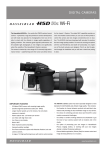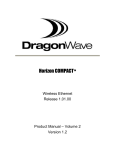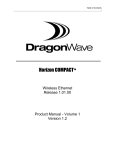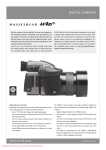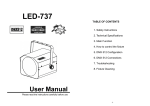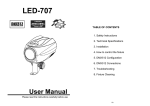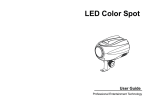Download User Manual
Transcript
LED-HC 50 TABLE OF CONTENTS LED HANDY CON 50 1. Safety Instructions 2. Technical Specifications 3. Function 4. Installation 5. DMX512 Address setting 6. How to control the fixture 7. DMX 512 Connection 8. Troubleshooting LED-HC50 9. Fixture Cleaning User Manual Please read the instructions carefully before use 1- LED-HC 50 1. Safety Introductions LED-HC 50 2.Technical Specifications y A compact LED controller for all kinds of DC 24V passive RGB Fixtures. y Come with switch power supply inside y Built-in programs under Master/Slave mode triggered by music. Please read the instructions carefully which includes y 4 different ways of DMX addressing important information about the installation, operation and WARNING y Terminals for linking LED-Wall Dimmer, and it provides power to LED Wall Dimmer. maintenance. y Power input: 100-250V~50/60Hz y Power output: DC 24V y y y Please keep this User Manual for future consultation. If you sell the fixture to y Max Load: 50W another user, be sure that they also receive this instruction booklet. y Channels Unpack and check carefully there is no transportation damage before using the Channel 1 = Red fixture. Channel 2 = Green Before operating, ensure that the voltage and frequency of power supply match Channel 3 = Blue the power requirements of the fixture. Channel 4 = Dimmer / Strobe y Disconnect mains power before servicing and maintenance. y Dimension:332 x 70 x 40mm y Use safety chain when fixes this fixture. y Weight: 1 kg y In the event of serious operating problem, stop using the fixture immediately. Never try to repair the fixture by yourself. Repairs carried out by unskilled people 3. Function can lead to damage or malfunction. Please contact the nearest authorized technical assistance center. Always use the same type spare parts. y Do not touch any wire during operation and there might be a hazard of electric shock. y y To prevent or reduce the risk of electrical shock or fire, do not expose the fixture to rain or moisture. 1. DMX OUTPUT: output DMX signal There are no user serviceable parts inside the fixture. Do not open the housing 2. DMX INPUT: input DMX signal or attempt any repairs by yourself. In the unlikely event your fixture may require 3. LED: show the status of the unit service, please contact your nearest dealer. 4. DIP SWITCH: used to set the start address of the unit or choose functions 5. AUTO DMX ADDRESS: used to set start address automatically. 6. MICROPHONE: used to receive voice for sound control 7. POWER SOCKET: for power input 8. LED-WD CONNECTOR: used to receive the signal of LED-WD only 9. SIGNAL OUTPUT: output signal and power for light 2- 3- LED-HC 50 LED-HC 50 When you set the address by DMX controller and dip-switch at the same 4. Installation time, the order of the DMX controller will be invalid. 1. Ensure that mains power supply is off before installing or wiring the LED fixture 2. Unscrew the screws and connect the wires as diagrams below A. DMX address setting by dip-switches 3. Tight the screws. 1. Set the start address by dip-switch as the diagram below 2. Hold the AUTO DMX ADDRESS button for about 5 seconds, the LED lights blinking indicating the address is set successfully. Dip #1 #2 #3 #4 #5 #6 #7 #8 #9 # 10 Value 1 2 4 8 16 32 64 128 256 Master/Slave • Examples: Channel 01:dip / on : # 1(=1) Channel 05:dip / on : # 1, # 3(1+4=5) Channel 09:dip / on : # 1, # 4 (1+8=9) Channel 13:dip / on : # 1, # 3, # 4(=13) CAUTIONS:the LED controller total output power consumption is 50 watt. B. Auto DMX addressing 5. DMX512 Address Setting 1. The DMX address of fixture can be set automatically. Set all dip-switches to OFF Each fixture needs to have a start address set to receive the data sent by the and hold the AUTO DMX ADDRESS button of the first unit for about 5 seconds, controller. The address number is between 0-511 (usually 0 & 1 are equal to 1). The the fixture will be set the DMX start address to 1, and the other fixtures of the address, also know as the start channel, is the first channel used to receive chain will be set their own DMX start address automatically. instructions from the controller. 2. The LED fixtures use four channels, the next fixture’s will be automatic calculate their own DMX address, not need to calculate the DMX channels of each fixture There are four ways to set the fixture DMX start address: A. DMX address setting by dip-switches B. Auto DMX addressing in the chain. (Fixture 1 = 1, Fixture 2 = 5, Fixture 3 = 9, Fixture 4 = 13, Fixture…) 3. No need to turn the fixture off when you change the DMX address, as new DMX address setting will be effect at once. Every time you turn the fixture on, it will be C. Remote DMX address setting by CA-T DMX TESTER ready to receive DMX signal or run the built-in programs. D. Remote DMX address setting by universal DMX controller If you use the function B, C or D to set the DMX start address, the fixtures of the chain all DIP switch MUST be set to OFF. 4- 5- LED-HC 50 LED-HC 50 C. Remote DMX address setting by CA-T DMX TESTER 6. How to control the fixture The fixture can be set the DMX address remotely by CA-T DMX TESTER. Please There are three ways to control the fixture refer to the CA-T user manual to set the DMX address to the fixture. A. Control by DIP switches B. Control by Universal DMX controller C. Master/Slave operation A. Control by DIP switches Dip switches setting Mode Master Slave D. Remote DMX address setting by universal DMX controller Sound y Make sure the DMX cables of all units are connected. y Connect the first unit to a universal DMX controller. Chase y Connect all units to the mains so they are switched on. Use Dip switch 3, 4, 5 to choose chase speed (1-8) y Set all DMX-channels on your DMX-controller to zero (value 000). Fade y Set the DMX-channel, that you want to assign as DMX start address on you unit, Use Dip switch 3, 4, 5 to choose fade speed (1-8) tot maximum (value 255). Color y Press the “Auto DMX address” button on the unit shortly. Use Dip switch 6, 7, 8, 9 to choose color (16) y If you want to set another unit to the same DMX start address, simply press it’s “Auto DMX address” button and it will receive the same address. y Done! B. Control by universal DMX controller An example to make things clear: If you use a controller with 5 pins DMX connector, you need to use a 5 to 3 pin y We will set the DMX start address of a unit to 106: adapter. The fixture uses four channels. Please refer to the following diagram to use y Connect the unit to the DMX-controller as described above and make sure all is your controller to activate the fixture. switched on. y Set all DMX-channels on the controller to zero (000). y Now set DMX-channel 106 to maximum (255). y Press the “Auto DMX address” button on the unit shortly. y Done! Your unit now has DMX address 106! 6- 7- LED-HC 50 LED-HC 50 7. DMX512 Connection The DMX 512 is widely used in intelligent lighting control, with a maximum of 512 channels. 1. If you using a controller with 5 pins DMX output, you need to use a 5 to 3 pin adapter-cable. 2. At last unit, the DMX cable has to be terminated with a terminator. Solder a 120 ohm 1/4W resistor between pin 2(DMX-) and pin 3(DMX+) into a 3-pin XLR-plug and plug it in the DMX-output of the last unit. 3. Connect the unit together in a `daisy chain` by XLR plug from the output of the C. Master/Slave operation unit to the input of the next unit. The cable can not branched or split to a `Y` The fixture will allow you to link 16 fixtures together and operate without a controller. cable. DMX 512 is a very high-speed signal. Inadequate or damaged cables, In Master/Slave mode, the first fixture will control the others to give an automatic, soldered joints or corroded connectors can easily distort the signal and shut sound activated, synchronized light show. This function is good when you want an down the system. instant show. The first fixture it’s DMX input cable will have nothing connect it, and 4. circuit, when one of the units’ power is disconnected. the other fixtures will be set in slave mode automatically. Their DMX input cables connect the last fixture DMX output cable (daisy chain). Any fixture can act as a The DMX output and input connectors are pass-through to maintain the DMX 5. Each lighting unit needs to have an address set to receive the data sent by the controller. The address number is between 0-511 (usually 0 & 1 are equal to 1). Master or as a Slave 6. The end of the DMX 512 system should be terminated to reduce signal errors. 7. 3 pin XLR connectors are more popular than 5 pin XLR. 3 pin XLR: Pin 1: GND, Pin 2: Negative signal (-), Pin 3: Positive signal (+) 5 pin XLR: Pin 1: GND, Pin 2: Negative signal (-), Pin 3: Positive signal (+) 8- 9- LED-HC 50 8. Troubleshooting LED-HC 50 9. Fixture Cleaning Following are a few common problems that may occur during operation. Here are some suggestions for easy troubleshooting: The cleaning of internal must be carried out periodically. Cleaning frequency depends on the environment in which the fixture operates: damp, smoky or particularly dirty surrounding can cause greater accumulation of dirt. A. The fixture does not work 1. Check the connection of power and main fuse. y Clean with soft cloth using normal glass cleaning fluid. 2. Measure the mains voltage on the main connector. y Always dry the parts carefully. y Clean the external at least every 20 days. B. Not responding to DMX controller 1. DMX LED should be on. If not, check DMX connectors and cables to see if link properly. 2. If the DMX LED is on and no response to the channel, check the address settings and DMX polarity. 3. If you have intermittent DMX signal problems, check the pins on connectors or on PCB of the fixture or the previous one. 4. Try to use another DMX controller. 5. Check if the DMX cables run near or run alongside to high voltage cables that may cause damage or interference to DMX interface circuit. C. No response to the sound 1. Make sure the fixture does not receive DMX signal. 2. Check microphone to see if it is good by tapping the microphone. 10- 11- LED-HC 50 EC Declaration of Conformity We declare that our products (lighting equipments) comply with the following specification and bears CE mark in accordance with the provision of the Electromagnetic Compatibility (EMC) Directive 89/336/EEC. EN55014-2: 1997 A1: 2001, EN61000-4-2: 1995; EN61000-4-3: 2002; EN61000-4-4: 1995; EN61000-4-5: 1995, EN61000-4-6: 1996, EN61000-4-11: 1994. & Harmonized Standard EN60598-1: 2000+ALL: 2000+A12: 2002 Safety of household and similar electrical appliances Part 1: General requirements 12-







